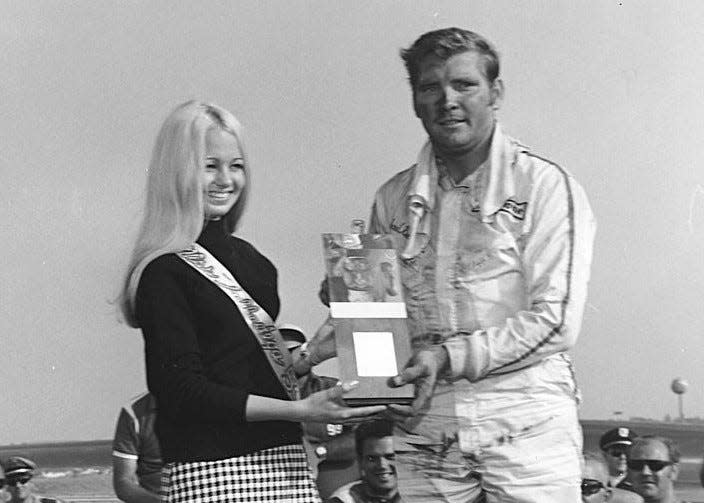NASCAR's Talladega Curse began with crazy winner and Richard Petty as chief boycotter
It started as a modest blast of research for the weekly NASCAR odds/prediction column, and as often happens along the drive, you drop-kick conventional wisdom and pick up a Back to the Future moment.
Here for the ride: Richard Brickhouse, tire problems, Benny Parsons’ little brother, and rabble-rousing labor activist Richard Petty. You heard me.
Let’s first lay waste to conventional wisdom. Sunday brings Talladega, which delivers our next restrictor-plate race, which means a proverbial crapshoot and therefore a chance at victory for underdogs like Corey LaJoie, Noah Gragson or John Hunter Nemechek.
Right?
NASCAR QNA Chase Elliott finally wins, but labor unrest is in NASCAR's future

Not exactly. In the plate-racin’ era, which began in 1988 to presumably help prevent 215-mph disasters, the closest Talladega has come to Victory Lane gatecrashers is David Ragan in 2013 and Ricky Stenhouse four years later. Both would go on to prove their plate-race acumen and, in hindsight, weren't shockers. Same for Bubba Wallace in '21.
Turns out, the fluke winners (or at least flukish) came back when the Haves routinely, and easily, outdistanced the Have Nots, week in and week out.
James Hylton got the first of his two career Cup wins in 1972, in a ’Dega race that saw most of the top stars crash or fall out with engine failure (aka: “She blowed up”). Hell, the only other car on the lead lap that day belonged to another underdog, one of the Keokuk Komets, Ramo Stott. Bobby Allison managed third.
After that came a here-and-there run of NASCAR one-hit wonders, fairly well-known racers at the time who normally settled back in the field, except for one afternoon in their careers.
Dick Brooks in 1973. Lennie Pond in ’78. Ron Bouchard in ’81. Bobby Hillin in ’86.
Allison’s scary crash in ’87 led to the horse-sapping rule change in ’88, and only that very first Talladega restrictor-plate race went to one of NASCAR’s supporting actors, Phil Parsons, who never won another Cup race.
Today from @TheSceneVault: Bobby Allison Remembers Talladega 1987https://t.co/0S0679e1B1 pic.twitter.com/qADJNVIy6T
— Jayski (@jayski) June 8, 2020
Since then, sister track Daytona has hugged several surprises — Derrike Cope, John Andretti, Trevor Bayne, Michael McDowell, etc. — while Talladega has belonged to the bluebloods.
In the very beginning, however, while a Who’s Who of star power split town, race day belonged to a “Who’s he?”.
When Talladega was too fast for Goodyear and Firestone
You’ve been hearing and reading about tires lately, specifically at NASCAR’s shorter tracks, where the racing hasn’t been very racy. Drivers point to two fixes: Better horsepower or worse tires.
NASCAR won’t let them increase horsepower for a variety of reasons that would bore you. And while more aggressive “tire wear” would certainly mix things up on the short tracks, Goodyear probably isn’t too keen on potential customers equating their racing rubber with exposed cords.
Bill France Sr.’s vision becomes reality as Talladega Superspeedway comes to life in 1969, turning the abandoned Eastaboga Airfield into Alabama International Motor Speedway. 🔙 #ThrowbackThursday 📰 https://t.co/ODsz4WDi95 pic.twitter.com/5rEFiqamCj
— Talladega Superspeedway (@TALLADEGA) September 16, 2021
Tire wear was Talladega’s “original sin.” Big Bill France had built a slightly larger, and therefore slightly faster, version of his prized Daytona speedway in eastern Alabama and it was ready for racing in September of ’69. Unfortunately, tires provided by Goodyear and its rival of the day, Firestone, were far from ready.
The Professional Drivers Association had formed in that decade — against Big Bill’s wishes, of course — and while it didn’t exert much leverage previously, the drivers decided against racing at 190 mph with time-bombs bolted onto the wheel assemblies.
But Big Bill had sold tickets for a race and had to have a race. So he allowed practically any race team on sight that week to enter — including teams from ARCA and NASCAR’s second-tier GT Series.
#TBT - 99 RIchard Brickhouse & 71 Bobby Isaac - 1969 Talladega 500 pic.twitter.com/k9ln6WKwoO
— Randy Murphy (@RMinENC) February 16, 2023
Richard Brickhouse was torn. He’d originally entered with the NASCAR regulars and was ready to walk away with them, but Chrysler officials offered him a ride in the high-profile car they were debuting that weekend: The Dodge Charger Daytona. The No. 99 Dodge was originally destined for Chargin’ Charlie Glotzbach.
Brickhouse would later say he was promised future work in a factory Chrysler if he’d stay and drive the No. 99. He did, he won, and never got the factory ride.
Back to the Future at Talladega
Fast-forward 55 years and, behind the scenes, some labor unrest has returned. It comes in the form of the decade-old Race Team Alliance, which is trying to negotiate for a better split of revenue when the new NASCAR/Network media package cranks to life next year.
Eventually, it might be nothing to worry about. Or it just might.
Meanwhile, also 55 years post-Brickhouse, we get a Talladega weekend with no tire issues and presumably no chance for an upset victory.
But keep in mind, there’s also something they eventually labeled the “Talladega Curse,” so don’t be surprised if Corey LaJoie wins when a Hendrick or Gibbs car blows a tire while leading on the final lap.
Speaking of Talladega ...https://t.co/kCjL85kBvj
— Ken Willis (@HeyWillieNJ) April 19, 2024
— Reach Ken Willis at ken.willis@news-jrnl.com
This article originally appeared on The Daytona Beach News-Journal: NASCAR '69: Richard Petty (Brickhouse), Talladega and used-up rubber

